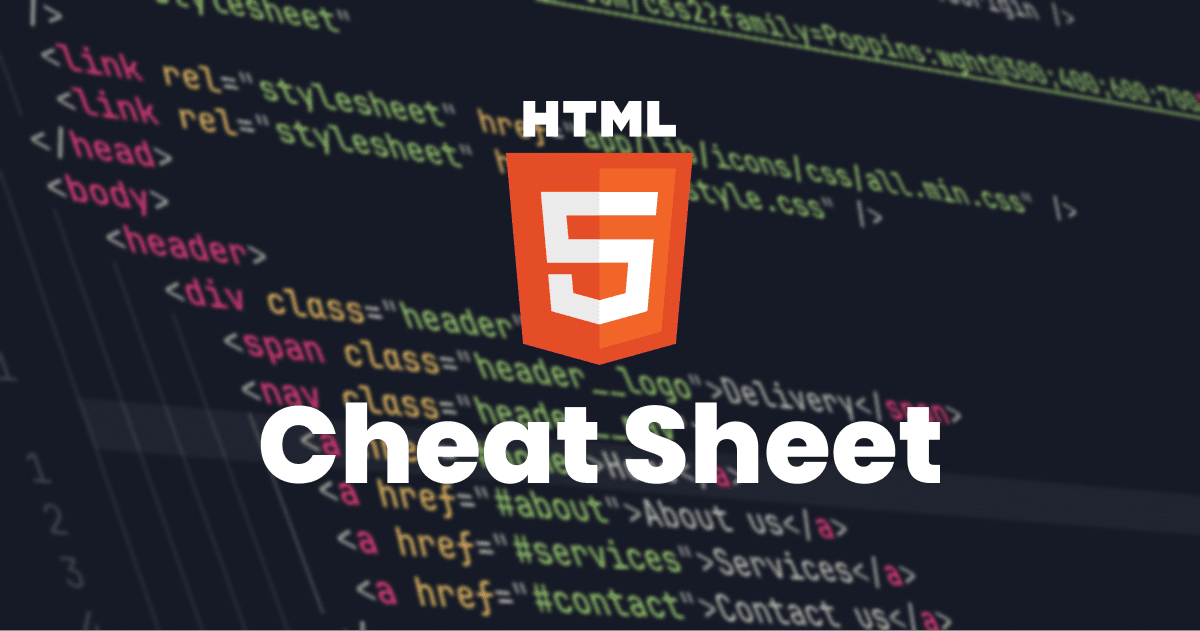The Ultimate HTML Cheat Sheet
Last Updated: August 16, 2024, By: Abdelhamid Boudjit, 12 min read.
HTML (Hypertext Markup Language) is the foundation of web development. Whether you're a beginner or a seasoned developer, having a cheat sheet at your fingertips can be incredibly handy. This article will serve as your ultimate guide, covering everything you need to know about HTML in a clear and easy-to-understand format.
-
Basic Structure of an HTML Document
Every HTML document starts with a declaration and follows a specific structure:
html<!DOCTYPE html> <html lang="en"> <head> <meta charset="UTF-8" /> <meta name="viewport" content="width=device-width, initial-scale=1.0" /> <title>Your Page Title</title> </head> <body> <!-- Content goes here --> </body> </html><!DOCTYPE html>: Defines the document type as HTML5.<html>: The root element of the document.<head>: Contains metadata and links to stylesheets, scripts, etc.<meta charset="UTF-8">: Sets the character encoding.<meta name="viewport" content="width=device-width, initial-scale=1.0">: Ensures proper scaling on mobile devices.<title>: Sets the title of the webpage.<body>: Contains the content of the webpage.
-
HTML Elements and Tags
HTML is composed of elements, each defined by a tag. Below are the most common tags and their functions.
-
Headings
Headings are used to define titles and subtitles on a page. HTML offers six levels of headings, from
<h1>to<h6>.
html<h1>Main Title</h1> <h2>Subtitle</h2> <h3>Sub-subtitle</h3>-
Paragraphs
Paragraphs are used to define blocks of text.
html<p>This is a paragraph of text.</p>-
Links
Links allow you to navigate to other web pages.
html<a href="https://www.example.com">Visit Example</a>-
Images
Images are embedded using the
<img>tag.
html<img src="image.jpg" alt="Description of the image" />-
src: The source of the image. -
alt: Alternative text for the image (important for accessibility). -
Lists
Unordered Lists:html<ul> <li>Item 1</li> <li>Item 2</li> <li>Item 3</li> </ul>Ordered Lists:html<ol> <li>First Item</li> <li>Second Item</li> <li>Third Item</li> </ol> -
Tables
Tables are used to display data in a tabular format.
html<table> <tr> <th>Header 1</th> <th>Header 2</th> </tr> <tr> <td>Data 1</td> <td>Data 2</td> </tr> </table><table>: Defines a table.<tr>: Defines a table row.<th>: Defines a table header.<td>: Defines a table cell.
-
-
Forms and Input
Forms are used to collect user input.
<form action="/submit" method="post">
<label for="name">Name:</label>
<input type="text" id="name" name="name" />
<input type="submit" value="Submit" />
</form><form>: The container for form elements.<label>: Defines a label for an input element.<input>: Defines an input field.type="text": Specifies the type of input (text, email, password, etc.).type="submit": Creates a submit button.
Common Input Types
type="text": Single-line text field.type="password": Password field.type="email": Email address field.type="number": Number input field.type="checkbox": Checkbox input.type="radio": Radio button.type="submit": Submit button.type="reset": Reset button.
-
Semantic HTML
Semantic HTML introduces meaning to the web page structure. Here are some important semantic tags:
<header>: Defines the header section of the page.<nav>: Defines a navigation menu.<section>: Defines a section of content.<article>: Defines an article.<aside>: Defines content aside from the main content.<footer>: Defines the footer section of the page.
<header>
<h1>Website Title</h1>
<nav>
<a href="#home">Home</a>
<a href="#about">About</a>
<a href="#contact">Contact</a>
</nav>
</header>
<section>
<article>
<h2>Article Title</h2>
<p>This is an article.</p>
</article>
</section>
<aside>
<p>Related content</p>
</aside>
<footer>
<p>© 2024 Your Website</p>
</footer>-
Multimedia Elements
-
Video
html<video width="320" height="240" controls> <source src="movie.mp4" type="video/mp4" /> Your browser does not support the video tag. </video>-
controls: Adds video controls (play, pause, etc.). -
<source>: Specifies the video file. -
Audio
html<audio controls> <source src="audio.mp3" type="audio/mpeg" /> Your browser does not support the audio element. </audio>controls: Adds audio controls (play, pause, etc.).
-
-
HTML Entities
HTML entities are used to display reserved characters or characters that are not on your keyboard.
<→<>→>&→&"→"'→'©→©®→®
-
Attributes
Attributes provide additional information about elements. Common attributes include:
id: Uniquely identifies an element.class: Assigns a class name to an element.style: Inline CSS styling.title: Provides additional information (appears as a tooltip).
<p id="intro" class="text-center" style="color: blue;" title="Introduction">
Hello World
</p>-
HTML5 APIs
HTML5 introduced several APIs to enhance the user experience:
-
Canvas
The
<canvas>element allows for dynamic, scriptable rendering of 2D shapes and bitmap images.
html<canvas id="myCanvas" width="200" height="100"></canvas> <script> var canvas = document.getElementById("myCanvas"); var ctx = canvas.getContext("2d"); ctx.fillStyle = "#FF0000"; ctx.fillRect(0, 0, 150, 75); </script>-
Geolocation
The Geolocation API allows you to access the user's location.
html<script> navigator.geolocation.getCurrentPosition(function (position) { console.log("Latitude: " + position.coords.latitude); console.log("Longitude: " + position.coords.longitude); }); </script> -
-
Code and Preformatted Text
The
<code>and<pre>tags are used to display code snippets and preformatted text in HTML.-
<code>TagThe
<code>tag is used to define a piece of computer code. It displays inline by default.html<p> To print "Hello World" in JavaScript, use <code>console.log('Hello World');</code> </p> -
<pre>TagThe
<pre>tag is used to display preformatted text. Text inside<pre>is displayed in a fixed-width font, and whitespace (such as spaces and line breaks) is preserved.html<pre> function greet() { console.log('Hello World'); } </pre> -
Combining
<pre>and<code>You can combine
<pre>and<code>to display code blocks with preserved formatting.html<pre><code> function greet() { console.log('Hello World'); } </code></pre><code>: Defines inline code snippets.<pre>: Preserves whitespace and line breaks.
-
-
Best Practices
-
Use Semantic Elements
Always use semantic elements to make your HTML more meaningful and accessible.
-
Alt Text for Images
Always provide
alttext for images to improve accessibility and SEO. -
Consistent Indentation
Use consistent indentation to make your code easier to read.
-
Avoid Inline Styles
Avoid using inline styles (
styleattribute). Instead, use external CSS.
-
-
Conclusion
This cheat sheet covers the essential elements and attributes of HTML, but HTML is a vast language with a lot more to explore. Keep this guide handy as you work on your projects, and remember that the key to mastering HTML is practice and continuous learning.
Happy coding!
